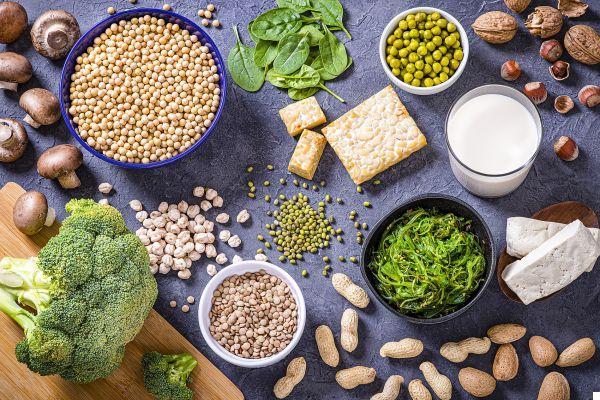
The year of Covid-19 saw a boom of vegan and vegetarian products (+ 14%, source Everli, online shopping platform). In the villages the desire for a healthy and eco-sustainable diet is growing more and more, which chooses to decrease the consumption of animal proteins in favor of vegetable proteins. For this we asked Michele Riefoli, nutritionist biologist and member of the scientific committee of Assovegan (Vegan Association of the village), to explain how to introduce green proteins in a balanced diet.
Where are plant proteins found
«Vegetable proteins are found in dried vegetables (beans, chickpeas, lentils, cicerchie, etc.) in a proportion of 23% (meat and fish have a protein content ranging from 17 to 20%), while soy it provides 36%. In the Whole grains (wheat, rice, spelled, barley, oats, rye, millet) it is found on average 12-15%. Finally in the dried fruit: walnuts, almonds, sesame and sunflower seeds have about 10% of them », says Riefoli (author of the book The integral revolution, Mondadori).
Compared to animal protein sources, they have the advantage of containing less fat, but they do not have all the essential amino acids. How to do? Just "mix" them by combining, for example, cereals and legumes, to satisfy the entire amino acid requirement of our body.
How much protein to eat
«The protein requirement of each of us is calculated on the basis of age, sex and pathophysiological conditions. In Europe, Larns (Recommended Nutrient Intake Levels) indicate that in a healthy adult population (over 18 years, including the elderly), the requirement is included. between 0,66 and 0,83 grams per kilo of body weight.
It is important not to exceed in protein intake because this involves a greater commitment of the liver and kidneys to dispose of the ammonia and urea produced by the catabolism of amino acids. In terms of calories they should not exceed 10%. Let's take an example: an adult who weighs 70 kilos and follows a diet of 2000 calories a day, should not consume more than 50 g of protein (10% of 2000 is 200, and since 1 g of protein corresponds to 4 calories, 200: 4 is equal to 50 g) ".
In what proportions to eat proteins
«According to the Mediterranean diet, the caloric percentages of a correct diet are 55-65% carbohydrates, 20-30% fat and 10-15% proteinSays Riefoli.
«I think that the percentages can be varied a 70, 20 and 10. But be careful: 70% of carbohydrates does not mean gorging on bread, pizzas, focaccia (much less made with 00 flour), potatoes, sweets and snacks. In addition to fruit and vegetables, it is necessary to give preference to i whole grain cereals as far as carbohydrates are concerned, dried fruit, oil seeds and extra virgin olive oil as regards fats and legumes for the protein share ».
2 RECIPES TO TRY
- Chickpea cream
For 2 people
Ingredients: 8 tablespoons of chickpeas already soaked or sprouted, ½ clove of fresh garlic (or onion, leek, shallot), 10-15 desalted and pitted black olives, 1 sprig of rosemary (or fresh or dried oregano), 1 cherry tomato dry, 1 tablespoon of oil
After having cooked the chickpeas, they are passed to the chopper together with the rosemary, garlic, dried tomato and black olives. Add a little water, and cover with a drizzle of extra virgin olive oil. Put the chickpea cream in the refrigerator for 1 hour before consuming it. It is used to season sprouted or cooked cereals, pasta, bruschetta, canapés or as a sauce for vegetarian sandwiches or for stuffed vegetables. It can be kept in the refrigerator for 3 days.
- Celery lentils
For 2 people
Ingredients: 6 tablespoons of soaked or sprouted lentils, ½ carrot, 1 stalk of celery with leaves, ½ courgette, 1 tomato, ½ dried cherry tomatoes, garlic, parsley, extra virgin olive oil
Put the soaked lentils, the carrot, the celery stalk with the leaves, the courgette into small pieces, the ripe tomato cut into cubes and ½ dried tomato cut into thin strips in the pot. Add water for three times the volume of the solid part. Bring to a boil, then simmer, covered, for 20 minutes. Turn off and add 2-3 thin slices of garlic, a sprig of chopped parsley and 1 tablespoon of extra virgin olive oil. Serve with wholemeal bread croutons. Excellent second course, they are perfect combined with a cooked whole grain (rice, barley, spelled or pasta).


























